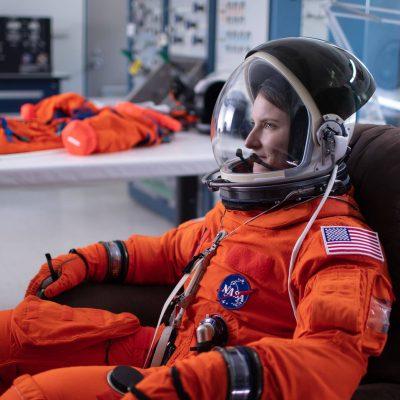One of the largest festivals of its kind in the country, the annual Cambridge Festival, which features over 360 mostly free events, runs from Friday 17 March until Sunday 2 April.
An event that promises to be one of the highlights of the Festival is ROCKET WOMAN (20 March) with Kayla Barron. Kayla is a NASA astronaut supporting 24/7 operations on the International Space Station (ISS) and preparing for NASA’s Artemis missions, which will soon be heading back to the moon for the first time since 1972. It will be the first time a woman walks on the moon, and Kayla is among those hoping to make history. Last year, she returned from six months on the ISS where she and her crew conducted hundreds of scientific investigations covering a wide range of disciplines.
A hugely engaging speaker, Kayla is in conversation from Houston with Cambridge astronomer Dr Matt Bothwell about all things space. Kayla has strong ties with Cambridge where she did her master’s in Engineering as a Gates Cambridge Scholar. Dr Matt Bothwell is a public astronomer at Cambridge University’s Institute of Astronomy and an accomplished author. Kayla discusses how she trained for life outside gravity to what it’s like to see the Earth from outer space and live beyond the clouds. Kayla is live from Houston and Dr Bothwell is live in Cambridge.
The mystery of gravity has captivated us for centuries. But what is gravity and how does it work? Distinguished astrophysicist Professor Luciano Rezzolla discusses his new popular science book, The Irresistible Attraction of Gravity: A Journey to Discover Black Holes (Cambridge University Press, March 2023) and provides a virtual journey into Einstein’s world of gravity during his talk THE IRRESISTIBLE ATTRACTION OF GRAVITY (17 March, online). He delves into the bizarre and often counter-intuitive world of gravitation, explaining some of the most curious consequences of gravitational physics, such as black holes, neutron stars and gravitational waves. As one of the key scientists involved, Professor Rezzolla examines how one of the most impressive scientific achievements of recent times, the first image of a supermassive black hole, M87*, was made, how the image was captured, and reveals what happens to matter and light near a black hole.
Luciano Rezzolla is the Chair of Theoretical Astrophysics and Director at the Institute for Theoretical Physics in Frankfurt, Germany. He is a member of the Event Horizon Telescope Collaboration (EHTC), where he sits on the Executive Board.
Another renowned scientist, Dr Helen Mason OBE, is also set to speak at this year’s Festival during THE SUN, OUR STAR (25 March). The Sun is just waking up from a quiet phase of its activity cycle. Several solar space observatories have been watching the Sun over the past few decades: SoHO, Stereo, Hinode and the Solar Dynamics Observatory. NASA’s Parker Solar Probe was launched in August 2018 and ESA’s Solar Orbiter in 2020. These satellites will travel closer to the Sun than ever before. Dr Mason reviews what we have learnt about our dynamic Sun, what we know about sunspots, solar active regions and flares (huge explosions), and how the Sun affects the Earth’s environment (space weather).
Dr Helen Mason OBE is a solar scientist at the University of Cambridge. She has worked on many joint NASA, ESA and Japanese solar space missions. She is an expert in solar UV and X-ray spectra and atomic physics. Dr Mason shares her enthusiasm and expertise about solar physics. This event is geared towards a younger audience.
Quantum sensors are probably the least discussed part of quantum technologies. But while practical quantum computers, with their fascinating future possibilities, remain quite a distance away in the future, quantum sensors are a reality today. In particular, the humble atom is nature’s most powerful quantum sensor, and its unparalleled precision has been harnessed for decades in atomic clocks to literally define our time. However, to achieve this timing precision, physicists must shield the atoms from all unwanted external influences such as magnetic fields. But what about influences we cannot shield against? For instance, gravity or dark matter.
In his talk, THE UNIVERSE IN AN ATOM: ATOMS AS QUANTUM SENSORS FOR FUNDAMENTAL PHYSICS (27 March), Professor of Many-Body Physics Ulrich Schneider explains how we can turn this apparent limitation into a new tool to explore the universe and fundamental physics. Professor Schneider explores what makes atoms so powerful as quantum sensors before taking a quick tour of the history of atoms as quantum sensors. He then takes a closer look at current plans to build large-scale atom interferometers that are sensitive enough to detect gravitational waves, hunt for dark matter and look for unknown physics.
Finally, there is an abundance of in person activities to inspire all ages during the Festival. On 18 March, the INSTITUTE OF ASTRONOMY opens its doors for an afternoon of interactive events and activities, and children can create their own space story during COSMIC CREATIVE WRITING WITH A SCIENTIFIC SPIN: A TRIP TO OUTER SPACE. On 25 and 26 March, a series of drop-in sessions during SUNSPACEART: SUN AND SOLAR SYSTEM POP-UP offers the chance for all budding cosmologists to learn more about the sun and solar system in a fun, creative way. Geared more towards adults, there is an immersive evening of stargazing and poetry readings during POETRY IN THE STARS (23 March), and in SPECTRUM SCIENCE (26 March), viewers get to see the universe in a whole new way during this intergalactic show.
For these and other related events, please visit the festival website for further information and to book seats: www.festival.cam.ac.uk
Image: Kayla Barron, credit: NASA



